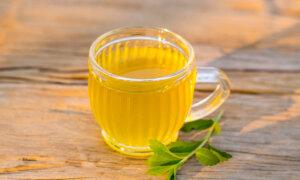Just half a cup a day may be helpful for the prevention of arteriosclerosis, cerebral thrombus, heart attack, and stroke—in part due to its ability to relax your arteries and improve blood flow.
STORY AT-A-GLANCE
- Green tea, which comes from the Camellia sinensis plant, contains a wealth of beneficial polyphenols, including the catechins epigallocatechin [3-]gallate (EGCG), epicatechin gallate, epigallocatechin and epicatechin.
- EGCG may be helpful for the prevention of arteriosclerosis, cerebral thrombus, heart attack and stroke—in part due to its ability to relax your arteries and improve blood flow.
- Green tea, consumed either in the form of a beverage or extract for two weeks or more, significantly lowers systolic blood pressure and diastolic blood pressure.
- A meta-analysis involving 25 randomized controlled trials also concluded that long-term tea intake—defined as 12 weeks or more—significantly improved blood pressure.
- Drinking about 0.5 to 2.5 cups of green tea daily for at least one year reduced the risk of developing high blood pressure by 46 percent, while those consuming more than 2.5 cups reduced their risk by 65 percent.
Polyphenols in Green Tea Responsible for Blood Pressure Lowering Effects
Green tea, which comes from the Camellia sinensis plant, contains a wealth of beneficial polyphenols, including the catechins epigallocatechin gallate (EGCG), epicatechin gallate, epigallocatechin and epicatechin.5“In vitro studies have shown that green tea catechins exert a cardioprotective effect through multiple mechanisms, including the inhibition of oxidation, vascular inflammation, and thrombogenesis, as well as the improvement of endothelial dysfunction. Animal studies have also revealed that green tea catechins influence nitric oxide production and vasodilation, thereby improving endothelial dysfunction and hypertension in rodents.”
Green Tea Significantly Reduces Blood Pressure
A meta-analysis of 24 randomized placebo-controlled trials assessed the effects of green tea supplementation on blood pressure.16 Green tea, consumed either in the form of a beverage or extract for two weeks or more, significantly lowered systolic blood pressure and diastolic blood pressure.- Increasing the concentration of nitric oxide in the plasma, which may inhibit proinflammatory cytokines and platelet aggregation, while improving endothelial dysfunction. In endothelial dysfunction, large blood vessels on the heart’s surface become narrower instead of dilating.18
- Anti-inflammatory effects, including suppressing inflammatory factors like cytokines, nuclear factor-kappa B, and adhesion molecules.
- Suppressing the contractile response, resulting in vasodilation and reduction in blood pressure.
“The BP-lowering effect of tea may be associated with its antioxidant properties and endothelial protection. Tea and their flavonoids could act as antioxidants by scavenging reactive oxygen species and nitrogen species, and chelating redox-active transition metal ions.
“… Tea intake has been reported to have various beneficial effects on vascular function, such as anti-inflammatory effects, anti-platelet effects and anti-proliferative effects. Thus, these effects may also be involved in potential mechanisms underlying the benefits of tea intake on BP.”
How Much Green Tea Is Beneficial?
Studies vary on the exact amount of tea to consume for heart and blood pressure health. Among Japanese adults, one study found consuming three to five cups of green tea daily led to a 41 percent lower risk of mortality from cardiovascular disease compared with not drinking green tea.22What Else Is Green Tea Good For?
The tea plant Camellia sinensis has been used medicinally for thousands of years, and its polyphenolic compounds may affect glucose metabolism and insulin signaling, along with a host of additional benefits. For instance, tea, particularly green tea, has been linked with a reduced risk of stroke, diabetes and depression, and improved abdominal obesity and glucose levels.26“Adiponectin, the key component in the interrelationship between adiposity, insulin resistance, and inflammation, is inversely proportional to the incidence of diabetes in different populations. In a meta-analysis, supplementing green tea was reported to increase the adiponectin concentrations in patients with T2DM, thereby reducing the possibility of diabetes.
“Green tea catechins have been shown to actively modulate the activity or expression of several receptors and enzymes involved in the absorption, metabolism transport, and synthesis of carbohydrates.
“… Green tea and its constituents have been reported to positively improve several physiological parameters in clinical subjects with diabetes, such as body weight, body mass index, body fat, and lipid profile, thereby improving living conditions.”Aside from diabetes, these compounds have anticancer effects that may help prevent lung, breast, esophageal, stomach, liver and prostate cancers,31 along with anti-inflammatory and antioxidant properties.
How to Choose High-Quality Tea
Green tea is among the least processed kinds of tea, which is why it contains some of the highest amounts of EGCG and antioxidants. Unlike other teas that you steep and strain, Matcha tea comes in the form of a powder that you add right into the water.Besides being an excellent source of antioxidants, green tea is also packed with vitamins A, D, E, C, B, B5, H, and K, manganese and other beneficial minerals such as zinc, chromium, and selenium. A telltale sign of high quality is that the tea is in fact green. If your green tea looks brown rather than green, it’s likely been oxidized, which can damage or destroy many of its most valuable compounds.
Choosing loose-leaf tea is also preferable to tea bags, as the bags may be made with heat-resistant polypropylene to prevent the bag from breaking apart in hot water. This means tiny pieces of plastic likely end up in your drink.
Paper tea bags are treated with epichlorohydrin, a chemical to prevent tears, which has been found to be a probable human carcinogen. Epichlorohydrin reacts with water to form 3-MCPD, another possible human carcinogen.
◇ References:
- 1 Tea Association of the U.S.A.
- 2 World Health Organization, Cardiovascular diseases
- 3, 5, 15 Medicine (Baltimore). 2020 Feb; 99(6): e19047., Intro
- 4, 16 Medicine (Baltimore). 2020 Feb; 99(6): e19047
- 6 Oxid Med Cell Longev. 2009 Nov–Dec; 2(5): 270–278. doi: 10.4161/oxim.2.5.9498, Abstract
- 7 Nutrients. 2010 Dec; 2(12): 1231–1246., Intro
- 8 Front. Nutr., 21 September 2018
- 9 Crit Rev Food Sci Nutr. 2020;60(4):626-659. doi: 10.1080/10408398.2018.1546669. Epub 2019 Jan. 7
- 10 Nutrients. 2010 Dec; 2(12): 1231–1246., 2. Classification of Polyphenols
- 11, 31 Int J Mol Sci. 2020 Mar; 21(5): 1744
- 12 Journal of Biological Chemistry May 31, 2018, doi: 10.1074/jbc.RA118.002038
- 13 Infectious Agents and Cancer 2017; 12: 36
- 14 Eur J of Cardiovascular Prevention & Rehabilitation, June 2008, 15(3):300-305
- 17 Medicine (Baltimore). 2020 Feb; 99(6): e19047., Discussion
- 18 Stanford Medicine, Endothelial Dysfunction
- 19 British Journal of Nutrition Aug. 19, 2014
- 20, 21 British Journal of Nutrition Aug. 19, 2014, Discussion
- 22 Stroke. 2021 Mar; 52(3): 957–965
- 23 JAHA Dec. 21, 2022, Clinical Perspective
- 24 JAHA Dec. 21, 2022, Risk of Cardiovascular Disease Mortality According to Green Tea Consumption
- 25 Curr Med Chem. 2008; 15(18): 1840–1850., Intro
- 26 Curr Opin Clin Nutr Metab Care. 2013 Nov;16(6):688-97
- 27, 28 Nutrients. 2019 Jan; 11(1): 39., 6.4
- 29 Nutrients. 2023 Jan; 15(1): 37., 2.1
- 30 Nutrients. 2023 Jan; 15(1): 37., 2.1, 2.2
- 32 Appl. Sci. 2021, 11(11), 5087; doi: 10.3390/app11115087
- 33 Journal of Chromatography A Sept. 5, 2003, Volume 1011, Issues 1-2, Pages 173-180
- 34 Purdue University Nov. 13, 2007
- 35 Molecular Nutrition & Food Research Sept. 13, 2007
- 36 Journal of Food Science and Technology Dec. 6, 2022







